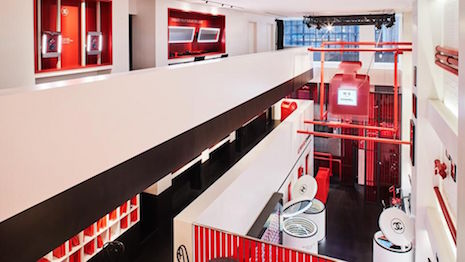NEW YORK – As more luxury brands are getting up to speed with ecommerce, companies also need to adapt how they value and measure customer experience.
Customer service metrics do not always reflect actual customer experiences. Speaking at Luxury FirstLook 2019 on Jan. 16, the CEO of Customer Experience Group encouraged marketers to rethink how they gather consumer data and from whom.
“Customers are the ones talking about the brand, so the marketing was kind of reverse marketing,” said Christophe Caïs, CEO of Customer Experience Group, Dubai. “It was no longer what brands were telling customers but what customers were saying about the brand.”
Luxury Daily produced Luxury FirstLook 2019: Digital Acceleration
Feedback fatigue
When evaluating customer service experiences, Mr. Caïs encourages brands to begin with the customer journey rather than technology.
Brands must also ask themselves “what, why, when, where and how” when they are evaluating what metrics to measure. Looking beyond customers who purchased items and also getting feedback from those who did not complete transactions is also crucial.
Companies also need to consider feedback fatigue when creating customer experience programs.

Customer experiences are omnichannel. Image credit: Chanel
As consumers are constantly asked to provide feedback for their experiences with stores, services and more, it can become frustrating – particularly if customers do not perceive their comments and concerns as having an impact on companies.
Brands also have a tendency to measure customer service through unique channels, but that is not necessarily how consumers themselves view shopping experiences. Most shoppers view email marketing, ecommerce, in-store and other channels as a whole.
Mr. Caïs also encourages companies to evaluate team members' experience, since that is one way brands differentiate themselves in the retail world.
“You might be performing well in each individual channel, but the connection between those channels is broken,” Mr. Caïs said. “You can’t think of customer experience in isolation.”
Ecommerce yardstick
Brands need to choose priorities when improving customer experience, but when it comes to ecommerce, Mr. Caïs says that online retailer Amazon is the yardstick.
Amazon's strategies can serve as an example to luxury retailers as they hope to make inroads with their online shopping strategies.
While Amazon continues to grow, its penetration into the most affluent households has decreased in recent years, according to research from the Shullman Research Center.
Luxury brands continue to ostracize the retailer, worried that its counterfeit goods and tendency to discount would hurt the brand too much to justify the revenue increases. Nevertheless, affluent classes’ growing affinity for the marketplace provides a provocative counterpoint arguing for its eventual integration into the luxury industry (see story).
Amazon and department store chain Nordstrom are among the brands offering the best customer service experiences and emotional connectivity, according to a report by global customer agency C Space.
Consumers prefer to spend their money on emotionally-cognizant companies that provide quality customer service, directly benefiting brands' bottom lines. The more emotionally connected shoppers are, the more likely they are to make frequent purchases and recommendations (see story).
“A big mistake [brands make] is wanting to be good everywhere, but you can’t be good everywhere,” Mr. Caïs said. “Where do you want to be different?”
{"ct":"k37YlJ+BO\/ZiMEY2w52odjN1xlK0A4EbKxgvc5kix7CAsgGKxuZ8LxT8ioYPw4h6lPbHk7hyGkooGSv+dybfEhH2\/vbPJEBXtA8SgnUpE4hejecn56kTMzWkatdOd7J9FztIOSfMdRmBGppZz7x9hLNwVR+SxMY6So42lxFNOXYqllfHpPNwPqyd1tqi4wLX4Hv9ikYjNrNWunn5Xt6ICbdaJGA6JXlOn94hLfTM+i\/dSxsYj1z+vSa0L6+8dY+kFv2CO1nRYKFfjK4wBgkZX8+utAQA+R55\/zgRgpTRUUIlGAEeJcc4B7YDS3qo1pFiP6\/Gm5UJqT6V9DBed1el+oXCvhkQq95VpWKkinSqr4CXxMKSH9JGOZs\/ZCYmOuN+MxLooFM1QCORtDY2\/e9vSfKBgsVCENQ3vBQNeH2iGqglD\/yamwwYDheOwQCVx4BZUTVXxD9pQqDExQf4DZRE4DPPIZpcEnyjNZEqXhpbfaqOG4VzcybjtVsdW5qfKWWrcFXALU\/+HuYKLlNqSSjCXW6b4phuTffE8uCN+h6rZi61rYs3ctDfG1AXO7uvCWdIbPwuGYe4kJ1T5jpRvPCCqemtNo5iTnHfNh\/1MvhVyCakshE8rkYwxdKV1xf3AEc1qHknUkdFUlgbi4H4UWR2iKBpjWJ3PusyV8B7dZJ0Ff0KEnw3qbO39JtbywzX\/\/CwcCTe1SqmwieDYHngL1Y46h3\/p7MqdabKIUhhISMrglG\/fk1rS2EsoTvN9HuCZQ8ScCNC6osuc0cV9rbkZ+GeEZJ\/86Jx7RGxpg09CBJ5nYK3ULD1X6SEDFjS9ZXTy1dHyBoRDlRuPdIft8KK1sK8wsswk6NiQejOk8t4jg5Q9f6Wt2PDQ5CUkuUHZXkv564MGFk8ie0SRTqCxw9bPkfiAtYA6xkDTsGoFyPHA1KfAgctd\/BQXo44f8G9khbnIFyGt8+Us0Q\/KTA2jlpHn0iO1mZH1IQzGrhBYq0\/rpCA6\/8TSNe6yYp2OJJzgs\/a4zdYPoe4KpsVuAYzCLfFfbfAMrmtUtMXCdfjIWA7X\/P7PMohvnxrLGrKXyTvCkIaPrmp1GylS8g6Wf2dYIz8JewIwTa3qB0ClTKEoSQuMzc0P9wT\/HVfTa\/a6aNhZS4A2Tt2nhj3wpCYmoe++6WEtZ9R8pPP9eRWpfJmH2Phf3YjSyRm63CinbgKjxHt5gjYnwiDhxoxHiNTle4PUVwutdJ8a5KQYA5MGCb96zU58FfdEPamq7nDK+Rc6Qsi9PxgIDBUC4WiBom+lfVjmM8xfvDVSz5QSq3RFuyis\/59PAv0w3LempdH8EvUQGSbpwzYBnfz443JZYbo1Uud7HT6TH1\/4A5BStJMP1S16PRCnfcazh5n6vuzSeAvsQs5Uic1+oWDmbFHImE+fPG+gDOO7v1giAI\/wkdvQb\/CUWJpjR8CeGafl3L+KtufS+INaQWBep3dD\/wt576EDVH5nO3iCivqAnQWdpIGflGEG62VuhZZ96hAMVddgOm0IprGfDuYiCfryxdIWkFjZjMJ2JYaaJgPS8uGpiaBHKoJdIioeJc4ZxHP2L9\/9yu8STX5QNblU1Q8KfVQBhURoC4Nd6ESLk5FR+rZT+RGubSHMeW+IAu7C5euX09Xno4uy799uhzHGtykXeOzf14N9ZPCm9RWVT901wktL\/aUAMxBaVlVcHYk2l3cJjXiqPyXSsrtvJXkl5yYy86QsFE9v9CpZqgeqQWbit2+GrsbnMvkdLG6KNFHECLpelE9iMsVWAFdpMdWIqFSCa98cRh1FvYOdYpgTZX8bRGRo3RTLi7yXDz3VhbX9399vCqcSIxOczlCb9oP2+rcOZWb8zvkuPENGqQ7umeq1v7XZ9HBCX+7J+jEZlRZamS+RkD9Ls7409bbp2w+W6Q3cSTqmd1WkwWSDZrtCRNfaawZR3Cdk1x1r6ouhtQPzqwNa+KkeZswStlgjA\/dsPYomgRLDtPvMupUJRPS64yr2YYBGnRbytqUZQUf14GLJD9BfY3yGaUVmK2aW6D9m4RYO10X0\/Kvl1PG0cPMKKk4Mafaaf3K9Sj9OElyRx+AMUaNSAnPhSDRy0OVCn1cQwkEEWVOstzsSmD5PZV6Rgk5leE7uq\/hY+wg4CGLrNQkjjHMMBsRl8w0\/og+8ModQ401MhdolfSDLOHY1dtrupUujiO9FMmPv7JMKgsmO5Ie5Z8qK6V+2IjOV5Mvt8uCYm8KrCverk2JTL5LR3fotlmAw6JL+z+lz4Azt8y6UFVVuSIpK9zh4aTPqtpdypbmSfBK1ILnM3LTPnLb\/PggXZVhiOak4gPzLu0CYsqoF0ck11\/\/eLgd\/U7O9QJJKvss88UYQyIF+\/d94fZ47TupW6MeLBc3C69pf2W7gaYsunIVmrzZx+D1Jr\/tViCE7bz+OjnvAlhuQQsHY4LUoX2BYJRVioZLa+MUcWasMYd4b1pHCO3wk\/\/KpUxlnSMKuXoOEqwdxlNZWt\/K8PEFshi4xmBIF3LnsBj3wINCPZbsXHNFDlSJIpr\/mYRXdjVCMY6ADAmfDuLM0Zlupyxo7YumAiwn4YVpBC9IIqPBbe5zA57FIs4EgSMG6d4QyqWqjWpKDw0z7jCDNubotJDFI68wlZDp+RxX6wqySwPSwQRrPAs8vnNrvSC9fG5J20Ypq0eGu2KQmf\/RMEiBtle\/3Dd9B0u9wgFk2WZvgaILiO89AI9lOu23OidW411AMjqqoSj7ZKjOfBOu2dzNZtq0qdnx0cbX9QIMoT7RBzNw+1fZi1wfaEUYyO44N2jaIbGdWc7JMLX6YcCh8i1XkVy0DrbLJtmqfObfYkO2FyCfGxGGwQug9RomgGbWqFnJjoTwzThw5dL361CzXolpJ8MIdSTeIWVgHnToE+ZS2i1FdjhOKmB8fcptCNCkVlHGzEGXCZDKJocTFFDR0kP3C+PkG4uxy2NeEmiDmtt+L4y98mvKPZ5bASHcTW09QZgJi7aI2gW3KLEeRDYS2l+T9hKZgKjoOLcyOLZgr50CAsDzmxmBqO4\/BypjPexZ2A7ElWIIXWMhNds2+evn67+kIyDgfsyPtTUnAdE7QFYYTlck5gVnKNx3b858ue9ZtrwZ2XCo6T1Iaa6OPI0IygyVK1x9cXhLNMi0TKZjT1XuPEZtLcScn68jMMF94\/HRtKrvT1UXSRcYjZKZwSQ+AnFbJ1tfh0yQ\/J79ryOl9Doco4gel+FCjkJOa0pzhkFCwGfMo\/0AMpa0BNveEfumzU\/RwzKIMg4AJhQ8mrSQXHwUy5bgsbrrMgcRAj2axbR46Ys6vAYfL9b61AS5I4DYhcDiQR6\/K0fcEaxfAQ2GkuEmqq0kqfnjy9fRjExwYy4Gc9\/SA61xuiJuHzqMUKL10vbFnqlXAMPs5VlDF6c94AURLYbtgrIDMKUAqOajBC\/KnbgInXrzdZFiU8Kerku2zQcP9jYWa9dzGn2FHgtqmh1N0G89n3fYa649OnHiuGWNkN6eSE66fNzNP9qts3EY58e6o2b0tyDs8Urcf1wAkzZmpeZYmGsT6G1B3JfUc8sY\/hvyhVOMj7Afvra7N21ybO13KxwgGj9tzKM\/b5T60UHFBYK9x0U+qCc2Op\/AVwc745W4sB0QB551tpSRAtKutRldkTAzEJGD5hYBUvyjbvh6PtfiCNTlh66quj0dWVqTIm4gxvDYgkX24ilmpLnDZWnPD0JfZwRbTGGjytrndIEFk8Gkhg6ecdFNPgBL6RehO\/5zQX6CB68OWvjpjYiNqhx\/WQjsInDhnLdhGUHZOSsSov8lUjXz\/DmygUpWhH\/BEsawPUnESGXdAq1XVEYW+PvbI9T8VP4Ez+yTYHFL+jHZ8wKWudJbGDyZmD0xiaCqsxZyZaDl8\/B9FAgTn27pbP+XwOJ3eldHsBC8gQ1stvYefrpvrZODXYlMGSxSgRuOW+8KE7oSILw73DLZPAruwacBv4gONKk7l5f3F2FloT2Mxjppu5wnZj6lBO8iAUXMKq91iZAo+30WLB9yyoFGz7ygNeoPwU71vBSb\/weQ2SXglO29lsjvjb8YOwbPxSNO7HhjVA8tj6xk\/6LP99PEwQ9ZDPKDdGy+AQxYdlh1ODWRI3fVZk9dNZItu2TiKxVdY9ckPt5IConTxlJ9eqQeZ81qNyu06rc17RlUIuWATg\/pQHM\/2Qq9dkoYI9j+N81+v1hWImQ1Hxzojz5NENm7TiuMREsT4s1ehrZWKMiZAaQrNUAjklti2I2OuID2h1Xf4GG9vwSxwy1r7IJPCnAP\/aYOdDZS8bGcaxyBS7K2crDQaNA2o0kKmRRThjOsLTmCwcp+\/g3TJ74Z0upxpIN3HH73uVMonb0P3XQLGCTBq2nAOrbUvj5zQExjt\/11lbyXnK4IppLpymAGeWoVN8AagRSqD4ecnWsblRFyDOMRIgP+1ds+gjerdi7ecpNGuiW7OSZ24oWCF1TtFf7LTcLgkaoyVJFfyQRSTsrToV4F+kYGY4eqAIQJsfWQJSGWTBTWZTzICOBtsCFeHjuMXb31nyLLxW9yoYFkGqckIl7HR1QwTaboD3hZm2TLdG9FdjuBNGXdH3roEsQhPdnhkqz592ZD1xFjPOMM31tvJ3Q3NujybsW2dK3AcbFyW60Oki88bCejiuShiquc5SffzyWy+DpZq798KbZpkC+VuKsEUNd\/1D45tvj+eAgo4l3mPQMMV9w\/q\/rvaM8r3JQgBoMjE34N\/fcTBaa0qbk93r4gPjE0CxVaxFDFMwJiwhoHIIDpQYiNmccK\/5+80tDD9wsKXXOU6KVoJOpxuKkFMkIlkM4swCfHt3mJ9PHX8\/0ocgHqWu6u5sxnAVLKl1p\/sSQbAwyCqHJ9D\/tX\/D4JFDcpYuLv5z9t2n5BTot5FvXstSzDMPRFWRLGIPOWU3FPzOxLk38GKwfvvHxa07qKyC1bc4RYOv2vm+jra+1aif9fLdC\/ySiNm1ND2GBxL2CM5CKDsaVpAEwjpq5uKBzFOTlDvT36V7n8E7OX3dSAVwHqUu2ffk0yx2w1m6h+tFhR1YkMfeMwfw4kl\/M29YAY6hOJ4JINwEIfmkKi2U9\/KEXv1UGglhnFR2WUdHcqchBRlQjOX3gUkEFkn9T+fxiuus72mv9GF4ar76mi2or3EQXQF1G7eqmH09dN31mg0FX3c+O9EW2mYwuhT4qfjchrxQnAIgqfPNVwNC1MBcAB4NASm3BdlqfAb30eiDd79s0LsqPFXFoD+oEGygZXRfmfI4SogckVE2E1ck4l7AwaqrJgU8QAH1SRIsoojDakT6\/XJlDWXedkYL9PYA1zaME8mPvGQ6WJRXQBz4TAPvRplWRM3Lq4H6QfYDtBwjLu0NQGlKKfdn\/Nkdqc9jYodXH3oIEm6eT4tW1JVQa2ji+pEJpFNZslLMHfygVz7ujzSNmYwTNqcNrAvFp16e73T7y70cN3o64k2jHH2AhwmVVyOM8Lq8FWE2tZi3QMwfsr1nax4znsHv3J3hk1aMwGCzraCDGZzR2UrDEMyulw\/M4FNXtcVQUVbLqcMp6eBvr2ifXja9p\/FHtlti87kXmZUdP46GaKufHoKpJr2j7sA0FStcimuBImJIILjfKl+by0JUHqZFdQGjLrfQKyOxcH298vkLsNqOtu3pQCrx+WjT7ozGHvEnTp26+BguY+E\/EVH8HhUpqhGXWyIj423Rmza\/pPY0UnI7IgQMArTrc68VOEOLMHmo\/a3OCP\/E6gaREIGtk2W0354ZHYHRp6BtcgkU+nPIjT2Zsr0\/tbDwcEzS4tvhczRaRBZIfBqbV5gW6igqzX3BwznKYYC5\/X4Ed2sed6uYRPc3FgWiYqRP\/JJxS4DQoNcs4N2Wf9Qrrl0Ah\/u\/H0F\/WD9zky4a9JxkRJCGtOKlgHwlky69j2sedv4dMdp0hq53K\/CJMKLEaqQ876joLrAr5LiA4wl8jQv+Vc7Jo9q7qzRyR7f3X0QH6kttm30M+cJcZ+vEtKRWWW8KOF5klhz7vTTERfGnGy8mrCKtIu+zgYCxVkee2CYe3A+NHxBnbOHAWMh3fc3Lm11R9cKsSVKuL3Ev438sSjbqbI5ceErVy9KReHwa5PTwmvYxzCyU2Sb1xHWxL8m0l6Z8y5se58+OtY443w8OnuC9pZ9BqJqS5lzWtIWblPVkK1pYLEM569UaeJIDy9fb7V7cmlip4fB7p+qT2vKGc1CfoiByR\/6Lv9nIB52Flvl5CXmhapP5WpvHnhnSzhfswOLZHUs4b9Bx5sj1I1XYIOGz7\/gcvQa4Me5w2yaki9JEfRR3lOkgdlDOMI+5CZtHz\/OBfldr2BMmxYf\/eFN6ofehd47If\/f124tGeJMqjDsrcjgRxJlxhePNsPKbN4n7Zat4C0y6s6WCYPyaRBggJz4CqsuMdqUi+kbf66PgMUrM44oltUemoXtB733eHp4mjvz8qJ+4OHWO7gs5x0YjfuuvffXcv5dYqD\/Jrh5jP4ldE+znGca\/0DUYzpjP9Obfr6DdY6VGk61xWlUiaZ6\/0Eubh9+RCSQ3CxXJve5hCK8zyLxdDG4kijbIgAEm\/HmvilTAQWDei6","iv":"9bbe0cb9a12303603e84a64d8605f191","s":"819d46309b83595b"}

 Automotive is one of the top categories where consumers want guided selling. Image credit: BMW
Automotive is one of the top categories where consumers want guided selling. Image credit: BMW